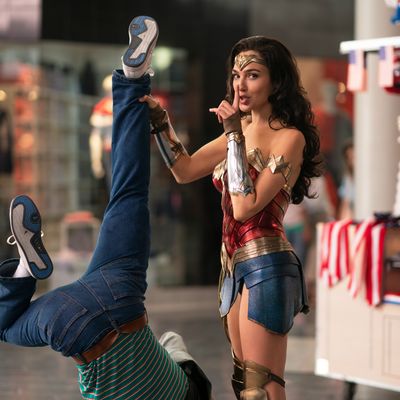
Earlier this week, a pair of disparate but not unrelated developments finally and fundamentally reshaped the way people will see — or more accurately, won’t see — movies for the remainder of 2020. On Monday, WarnerMedia announced a grudging peace accord with its rival Amazon that will finally allow the Burbank behemoth’s nascent OTT platform HBO Max to stream on Amazon Fire TV devices. And two days later, WarnerMedia’s studio division Warner Bros. announced that its repeatedly delayed summer tentpole Wonder Woman 1984 would arrive on HBO Max on Christmas Day (and in international movie theaters earlier in the month), in yet another experimental inversion of the way Hollywood rolls out its highest stakes titles in the mask-wearing era.
As a fitting coda to the Summer of No Blockbusters, Warners’ decision to domestically push WW84 straight to streaming effectively toppled the last megabudget four-quadrant crowd-pleaser left on this year’s theatrical release calendar — the only $200 million–budgeted soldier left standing on a battered movie battlefield where other presumed blockbusters — including Dune, No Time to Die, and Black Widow — recently retreated into 2021 (when a coronavirus vaccine is expected to be widely implemented). But arriving just weeks after Warner Bros.’ failure to launch its previous $200 million prestige-popcorn thriller Tenet toward profitability, the move had far-reaching implications.
Wonder Woman 1984 joins Disney’s Mulan as the second nine-figure event to head straight for living-room viewing (or what Hollywood euphemistically calls “direct to consumer” distribution), worsening the already perilous situation for the continent’s major movie theater chains, which are teetering on the brink of financial insolvency. And the film’s digital-first domestic release — which, notably, does not fall under the premium video on demand umbrella and will reportedly come at no additional cost to subscribers — can be read as the clearest indication to date of an overall strategy by WarnerMedia’s corporate parent AT&T to run its putting-out-movies offense through HBO Max, which up until this point has been getting battered in the streaming wars due to limitations of access.
“Warners has got this service that’s been floundering in last place and trying to get off the ground for some time now,” says Richard Rushfield, editor of the insider Hollywood entertainment industry newsletter the Ankler. “And here is a chance to put out a hit, and put something really solid behind it. They’ve expressed real ambivalence about their future in the theatrical world. So, taking a step away from a business they’re ambivalent about into something everybody has agreed is the future — and the only future that studios can ever have — even if it costs them a ton of money, it might make sense for them.”
Over the pandemic months, other studios have had a mixed bag of success releasing movies straight to streaming or PVOD. Universal drew the ire of the theater-owner community by skipping a theatrical release for Trolls World Tour, which grossed a surprisingly strong $100 million via premium video on demand, before forging an unprecedented agreement with AMC Theaters permitting the studio to stream its films on video platforms a mere 17 days after they are shown in theaters. (On November 17, Universal entered into a similar, multiyear deal with the theater chain Cinemark also reducing the until-now obligatory “window” between films’ theatrical and streaming bows.) Since the summer, Disney has gone all-in with its digital-first release scheme. The House of Mouse forewent theatrical rollouts for the $125 million big-screen blowup of Artemis Fowl, the filmed adaptation of Lin-Manuel Miranda’s smash musical Hamilton, and Mulan in a concerted effort to lure new subscribers to Disney+. But according to the streaming-platform-analytics firm Antenna, new subscribers only accounted for about 4 percent of Mulan’s PVOD rentals over its online opening weekend.
According to a rival studio executive who spoke to Vulture on background, the Wonder Woman 1984 digital pivot comes at a suspiciously transitional time. In the past week — as the all-but inevitable continuation of a high-profile spate of one thousand intended reorg layoffs — Warner Bros. has fostered the exits of chief marketing officer Lisa Gregorian, executive VP of marketing animation and family films Jim Gallagher, and Blair Rich, Warner Bros.’ head of worldwide marketing, who had been in a studio dead pool for months as rumors of her clashes with WB chairman Toby Emmerich swept Hollywood.
Moreover, until recently, the fledgling HBO Max (which had logged fewer than 9 million subscribers) had been unavailable to consumers on both Amazon Fire and Roku, the country’s most popular streaming TV devices. As some industry observers have noted, however, it’s no coincidence the studio made its WW84 announcement so close to the Amazon–HBO Now agreement, which provides access to a global audience of more than 40 million people. Roku, for its part, boasts 46 million active accounts.
Ultimately, only Hollywood historians will be able to tell whether Warner Bros. played its cards correctly by rolling out WW84 straight to streaming. “It’s a huge gamble,” says Rushfield. “A blockbuster is what fuels the whole studio. Having one or two of those a year is what fuels everything and creates the endless downstream revenue with toys and rides and cruise ships and tie-ins and God knows what. That’s the whole enchilada. That’s what you’re risking with this. You’re not risking it — you’re giving it away. It’s gone!”


